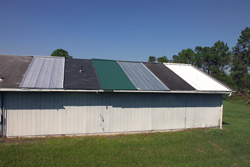Lead – Danny Parker (FSEC)
Lessons Learned:
- Reflectivity is fundamental.
- Spectrally selective products show excellent promise
- Long-term reflectance of metal products is generally
superior.
Sealed attic constructions should emphasize reflectance
for best performance. |
Improving attic thermal performance is fundamental to controlling
residential cooling loads in hot climates. Research shows that
the influence of attics on space cooling is not only due to the change
in ceiling heat flux, but often due to the conditions within the attic,
and their influence on duct system heat gain and building air infiltration.
To comparatively evaluate performance, BAIHP uses its Flexible Roof
Facility (FRF) to evaluate five roofing systems at a time against
a control roof with black shingles and vented attic (see picture).
The testing evaluates how roofing systems impact summer residential
cooling energy use and peak demand.
 |
FSEC's Flexible Roof Facility (FRF) allows side-by-side testing of multiple roofing systems.
Photo: Nick Waters |
Research over the last five years has achieved industry-changing results:
- Established the large influence of roof reflectivity on attic
thermal performance regardless of roofing type (shingles, tile,
metal).
- Long-term performance of painted and unfinished metal roofing
systems.
- Demonstrated the potential of infrared reflective spectrally selective
pigments leading to innovation of “cool colors” by U.S.
roofing industry (BASF, Shepard Paints).
- Provided research underscoring the need for more reflective shingles
leading to industry innovation (Elk Corporation, Cool Shingles)
- Comparative performance of different attic ventilation levels
on thermal performance and attic humidity
- Performance of sealed attic construction with roof deck insulation,
demonstrating the powerful combination of this method when combined
with more reflective roofing.
Resources:
Pertinent research articles can be viewed at:
http://www.fsec.ucf.edu/en/publications/pdf/FSEC-CR-1514-05.pdf and at http://www.fsec.ucf.edu/en/publications/html/FSEC-CR-1220-00-es/index.htm
Return to Energy Chronicle homepage

